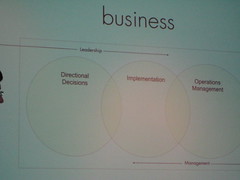 Image by joshdamon via Flickr
Image by joshdamon via Flickr
Computerworld magazine UK has an article direct from the Gartner BPM conference in London which talks about Gartner's analysis and survey of business leaders. According to Gartner the number one priority for IT business leaders is Business Process management. As the article states:
What's surprising about this - and has led some to question the findings - is that in the current economic climate BPm has become something which rates higher than cost cutting as a priority.
Personally I think it is spot on.
I've mentioned before on these pages that I align to the Jim Sinur view that good process management is actually a profit centre in an organisation rather than a cost centre. This means that any company focusing on, and prioritising, BPM will in effect also be cutting costs and increasing the bottom line. As Jim says in his article "Historically, well scoped BPM projects approach a 15% internal rate of return." That's pretty compelling stuff!
For example a lot of companies will look at 'trimming the fat', or 'reducing costs' by doing things such as cancelling a travel budget or slimming staff figures down. This has the effect of reducing headcount without reducing work and results in fewer people doing the same (or more) work than before. As a short term measure (and a way of makig sure that your employee's aren't coasting) this works. But this is untenable in the long run.
The only logical way to deal with reducing head count is to then ensure that the work those remaining people need to do is also reduced. This is through either automation or process redesign. Both of which are elements of BPm.
So for anyone involved in the world of BPm let's hope that Gartner's comments which heads this article holds true.
(Note that throughout this article I use a lower case 'm' when referring to BPm. This is to avoid the trap of people looking at this through a technology view but still trying to focus peope on the overall capability of managing business processes).
"We're in year one of the recovery. Recovery will take a few years. Thus you must do BPM — apply BPM practices — more than just gain the necessary competencies. It is 'all hands on deck' now. Do make changes. Later, you'll have to invest time and energy into increasing your competencies. But 2009 must be a year of action,"
What's surprising about this - and has led some to question the findings - is that in the current economic climate BPm has become something which rates higher than cost cutting as a priority.
Personally I think it is spot on.
I've mentioned before on these pages that I align to the Jim Sinur view that good process management is actually a profit centre in an organisation rather than a cost centre. This means that any company focusing on, and prioritising, BPM will in effect also be cutting costs and increasing the bottom line. As Jim says in his article "Historically, well scoped BPM projects approach a 15% internal rate of return." That's pretty compelling stuff!
For example a lot of companies will look at 'trimming the fat', or 'reducing costs' by doing things such as cancelling a travel budget or slimming staff figures down. This has the effect of reducing headcount without reducing work and results in fewer people doing the same (or more) work than before. As a short term measure (and a way of makig sure that your employee's aren't coasting) this works. But this is untenable in the long run.
The only logical way to deal with reducing head count is to then ensure that the work those remaining people need to do is also reduced. This is through either automation or process redesign. Both of which are elements of BPm.
So for anyone involved in the world of BPm let's hope that Gartner's comments which heads this article holds true.
(Note that throughout this article I use a lower case 'm' when referring to BPm. This is to avoid the trap of people looking at this through a technology view but still trying to focus peope on the overall capability of managing business processes).

